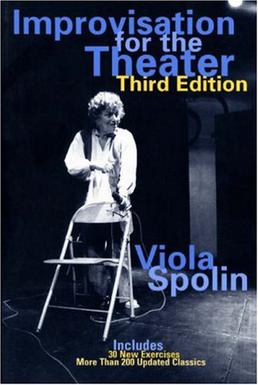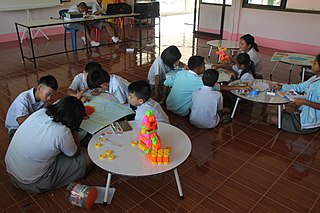Related Research Articles
Genius is a characteristic of original and exceptional insight in the performance of some art or endeavor that surpasses expectations, sets new standards for the future, establishes better methods of operation, or remains outside the capabilities of competitors. Genius is associated with intellectual ability and creative productivity. The term genius can also be used to refer to people characterised by genius, and/or to polymaths who excel across many subjects.

A polymath is an individual whose knowledge spans a substantial number of subjects, known to draw on complex bodies of knowledge to solve specific problems.

Creativity is a characteristic of someone that forms something novel and valuable. The created item may be intangible or a physical object. Creativity enables people to solve problems in new or innovative ways.

Collaboration is the process of two or more people, entities or organizations working together to complete a task or achieve a goal. Collaboration is similar to cooperation. Most collaboration requires leadership, although the form of leadership can be social within a decentralized and egalitarian group. Teams that work collaboratively often access greater resources, recognition and rewards when facing competition for finite resources.

Edward Charles Francis Publius de Bono was a Maltese physician and commentator. He originated the term lateral thinking, wrote many books on thinking including Six Thinking Hats.

Viola Spolin was an American theatre academic, educator and acting coach. She is considered an important innovator in 20th century American theater for creating directorial techniques to help actors to be focused in the present moment and to find choices improvisationally, as if in real life. These acting exercises she later called Theater Games and formed the first body of work that enabled other directors and actors to create improvisational theater. Her book Improvisation for the Theater, which published these techniques, includes her philosophy and her teaching and coaching methods, and is considered the "bible of improvisational theater". Spolin's contributions were seminal to the improvisational theater movement in the U.S. She is considered to be the mother of Improvisational theater. Her work has influenced American theater, television and film by providing new tools and techniques that are now used by actors, directors and writers.
Learning sciences (LS) is an interdisciplinary field that works to further scientific, humanistic, and critical theoretical understanding of learning as well as to engage in the design and implementation of learning innovations, and the improvement of instructional methodologies. LS research traditionally focuses on cognitive-psychological, social-psychological, cultural-psychological and critical theoretical foundations of human learning, as well as practical design of learning environments. Major contributing fields include cognitive science, computer science, educational psychology, anthropology, and applied linguistics. Over the past decade, researchers have expanded their focus to include the design of curricula, informal learning environments, instructional methods, and policy innovations.

Project-based learning (PBL) is a student-centered pedagogy that involves a dynamic classroom approach in which it is believed that students acquire a deeper knowledge through active exploration of real-world challenges and problems. Students learn about a subject by working for an extended period of time to investigate and respond to a complex question, challenge, or problem. It is a style of active learning and inquiry-based learning. PBL contrasts with paper-based, rote memorization, or teacher-led instruction that presents established facts or portrays a smooth path to knowledge by instead posing questions, problems, or scenarios.
James C. Kaufman is an American psychologist known for his research on creativity. He is a Professor of Educational Psychology at the University of Connecticut in Storrs, Connecticut. Previously, he taught at the California State University, San Bernardino, where he directed the Learning Research Institute. He received his Ph.D. from Yale University in Cognitive Psychology, where he worked with Robert J. Sternberg.
Design thinking refers to the set of cognitive, strategic and practical procedures used by designers in the process of designing, and to the body of knowledge that has been developed about how people reason when engaging with design problems.
The psychology of science is a branch of the studies of social science defined most simply as the study of scientific thought or behavior. It is a collection of studies of various topics. The thought of psychology has been around since the late 19th century. Research on the psychology of science began in 1874, the field has seen a substantial expansion of activity in recent years. The specific field of psychology as a science first gained popularity mostly in the 1960s, with Abraham Maslow publishing an influential text on the subject, but this popularity faded, only re-emerging in the 1980s. Other studies of science include philosophy of science, history of science, and sociology of science or sociology of scientific knowledge.

Computational creativity is a multidisciplinary endeavour that is located at the intersection of the fields of artificial intelligence, cognitive psychology, philosophy, and the arts.
Innovation management is a combination of the management of innovation processes, and change management. It refers to product, business process, marketing and organizational innovation. Innovation management is the subject of ISO 56000 series standards being developed by ISO TC 279.
Marino (Min) Sidney Basadur is a teacher, consultant and researcher best known for his work in applied creativity and as the developer Simplexity Thinking System for improving workplace innovation & creativity. He is president of Basadur Applied Creativity and professor emeritus of organizational behavior and innovation at McMaster University's Michael G. DeGroote School of Business.
John Baer is a professor of Educational Psychology at Rider University in New Jersey. He earned his B.A. from Yale University and his Ph.D. in cognitive and developmental psychology from Rutgers University.

Dean Keith Simonton is a Distinguished Professor Emeritus based in Davis, California, affiliated with the Department of Psychology at the University of California, Davis. Simonton is known for his research in the fields of genius, creativity, leadership, and aesthetics. His work focus into the cognitive, personal, developmental, social, and cultural factors contributing to eminence, giftedness, and talent across various domains such as science, philosophy, literature, music, art, cinema, politics, and war.
Creative education is when students are able to use imagination and critical thinking to create new and meaningful forms of ideas where they can take risks, be independent and flexible. Instead of being taught to reiterate what was learned, students learn to develop their ability to find various solutions to a problem. Coming up with various out-of-the box solutions is known as divergent thinking and there is no one way of cultivating this skill - largely due to the newness of the concept and the limited scientific information on creativity.
A Study of British Genius is a 1904 book by Havelock Ellis published by Hurst and Blackett.
Applied improvisation is the application of improvisational theatrical methods in various non-theatrical fields, including consulting, training, and teaching. It is known to be used as an experiential educational approach which enables participants to explore and improve their leadership, management and interpersonal capabilities in several fields, which include collaboration, communications, creativity, and team-building.

Clarence Windom "Win" Wenger Jr. was an American teacher and writer in the fields of creativity, accelerated learning, brain and mind development, and political economy.
References
- ↑ Sawyer, R. Keith (March 21, 2013). "The Creative Power Of Memory". Huffington Post.
- ↑ "The Three Types Of Relationship Every Creative Person Needs". September 14, 2016.
- ↑ Bailis, Rochelle. "Brainstorming Doesn't Work – Do This Instead". Forbes .
- ↑ "Creativity Myths – Interviews with Innovation Experts and Authors".
- ↑ Sawyer, R. Keith (2017). "Group Genius: The Creative Power of Collaboration". Basic Books.
- ↑ Sawyer, R. Keith (2013). "Zig Zag: The Surprising Path to Greater Creativity". Wiley.
- ↑ Sawyer, R. Keith (2024). "Explaining Creativity: The Science of Human Innovation". Huffington Post.